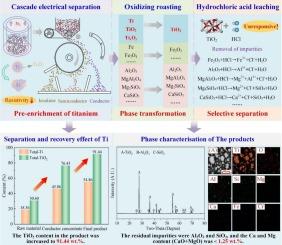Recovery of titanium from low-grade titanium alloy grinding scrap: Staged regulation of the conversion of Ti, TixOy to TiO2
IF 9
1区 工程技术
Q1 ENGINEERING, CHEMICAL
引用次数: 0
Abstract
Titanium alloy grinding scrap (TAGS) is a low-grade scrap produced by grinding during titanium alloy processing. Due to the high impurity content and complex phase composition, TAGS currently has no effective resource utilization pathway. In this study, a new method based on ball milling pretreatment, cascade electrostatic separation, oxidative roasting, and acid leaching was proposed to achieve deep separation and purification of Ti from low-grade TAGS. The results show that the resistivity between the titanium-containing phase and the impurity in TAGS varied greatly, and the resistivity of titanium metal was significantly lower than that of TixOy and TiO2. The stripping of the high-resistivity oxide layer from the surface layer of titanium metal was achieved by ball milling under an N2 atmosphere, which significantly enhanced the effect of cascade electrostatic separation. It was beneficial to increase the roasting temperature and time to promote the conversion of Ti and TixOy to TiO2. TiO2 with a rutile structure did not dissolve during the HCl leaching process. Except for corundum (Al2O3), most of the impurities (Fe2O3, MgAl2O4, etc.) would react with HCl and enter the solution as ions. Under the optimized conditions (ball milling time = 30 min, voltage = 21 kV, cascade electrostatic separation 3 times, roasting temperature = 950 °C, roasting time = 3 h), the Ti grade was increased from 18.36 wt% to 54.86 wt% with a TiO2 content of 91.44 wt%. The Ca and Mg content (CaO + MgO) in the products was <1.25 wt%, which met the requirement of titanium-rich material and realized the high-value utilization of low-grade TAGS.

从低品位钛合金磨屑中回收钛:Ti、TixOy向TiO2转化的阶段性调控
钛合金磨屑(tag)是钛合金加工过程中通过磨削产生的低品位废料。由于TAGS杂质含量高,相组成复杂,目前尚无有效的资源利用途径。本研究提出了一种基于球磨预处理、级联静电分离、氧化焙烧和酸浸的新方法,以实现低品位tag中Ti的深度分离纯化。结果表明,tag中含钛相与杂质之间的电阻率差异较大,其中金属钛的电阻率明显低于TixOy和TiO2。在N2气氛下,采用球磨法将金属钛表面的高电阻率氧化层剥离,显著提高了梯级静电分离的效果。提高焙烧温度和焙烧时间有利于促进Ti和TixOy向TiO2的转化。具有金红石结构的TiO2在HCl浸出过程中不溶解。除刚玉(Al2O3)外,大部分杂质(Fe2O3、MgAl2O4等)与HCl反应,以离子形式进入溶液。在优化条件下(球磨时间 = 30 min,电压 = 21 kV级联静电分离3次,焙烧温度 = 950 °C,焙烧时间 = 3 h), Ti年级从18.36提高 wt % 54.86 与二氧化钛含量为91.44 wt % wt %。产品中Ca、Mg含量(CaO + MgO)为<;1.25 wt%,满足了富钛材料的要求,实现了低品位tag的高价值利用。
本文章由计算机程序翻译,如有差异,请以英文原文为准。
求助全文
约1分钟内获得全文
求助全文
来源期刊

Separation and Purification Technology
工程技术-工程:化工
CiteScore
14.00
自引率
12.80%
发文量
2347
审稿时长
43 days
期刊介绍:
Separation and Purification Technology is a premier journal committed to sharing innovative methods for separation and purification in chemical and environmental engineering, encompassing both homogeneous solutions and heterogeneous mixtures. Our scope includes the separation and/or purification of liquids, vapors, and gases, as well as carbon capture and separation techniques. However, it's important to note that methods solely intended for analytical purposes are not within the scope of the journal. Additionally, disciplines such as soil science, polymer science, and metallurgy fall outside the purview of Separation and Purification Technology. Join us in advancing the field of separation and purification methods for sustainable solutions in chemical and environmental engineering.
 求助内容:
求助内容: 应助结果提醒方式:
应助结果提醒方式:


